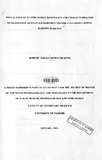| dc.description.abstract | The increasing prevalence of antimicrobial resistance is a major public health problem globally. In
Kenya and the rest of developing countries the problem of antimicrobial resistance is much pressing
especially due to high levels of infectious diseases and cost constraints which prevent the
widespread use of newer and more expensive agents. Multiple studies drawn from point-prevalence
assessment have recognized the role of commensal bacteria in the spread of antimicrobial
resistance. In veterinary medicine, the alarming state of bacterial antimicrobial resistance is seen in
examining the Escherichia coli isolates, where attention has been given to food-producing animals
such as pigs, cattle and domestic fowl. However, few studies have looked at the antimicrobial
resistance profiles in non-human primates. Therefore this study had the objective of assessing
antimicrobial drug susceptibility and genetic characteristics of antimicrobial resistance in
Escherichia coli from non-human primates.
A total of 100 faecal samples were collected using aseptic techniques from two groups of baboons
at the Institute of Primate Research (lPR), Nairobi Kenya. Thirty six faecal samples were from
group I baboons made up of 20 adult males and 16 females captured from Aberdare National park
and transported to IPR one month earlier. Sixty four faecal samples were from group II baboons
consisting of 64 adult male baboons that had lived at the IPR for a period of between one and 5
years. Ninety seven Escherichia coli were isolated by standard cultural, biochemical tests and final
identification using the API 20E system (Biolvlerieux) test. Antimicrobial susceptibility was
performed by the agar disk diffusion method as recommended by the Clinical and Laboratory
Standards Institute (CLSI). A total of 16 antimicrobial agents commonly used were tested and these
were: - ampicillin 10 ug, piperacillin 100 flg, amoxycJav 30 ug, ceftriaxone 30 ug, ceftazidime 30
ug, meropenem 10 ug, gentamicin 10 ug, amikacin 30 ug, kanamycin 30 ug, streptomycin 10 ug,
tetracycline 30 ug, co-trimoxazole 25 ug, sulfamethoxazole 100 ug, ciprotloxacin 5 ug, otloxacin 5
ug and chloramphenicol 30 ug. E. coli ATCC 25922 was used as a reference organism. DNA of
E.coli isolates were extracted by boiling method and thereafter specific polymerase chain reaction
(PCR) assays were used for the detection of genes for ampicillin resistance (blaTEM, bla SHY and
blacTx-M), chloramphenicol resistance (cmIA), and streptomycin resistance (aadA1 and aadA2)
using specific primers. The PCR products were detected by electrophoresis in 1.5% agarose gels. To
make sure that the amplification reaction had produced the desired gene segment Tracklt™ 1 Kb
DNA ladder was used to estimate the PCR products size. | en |

